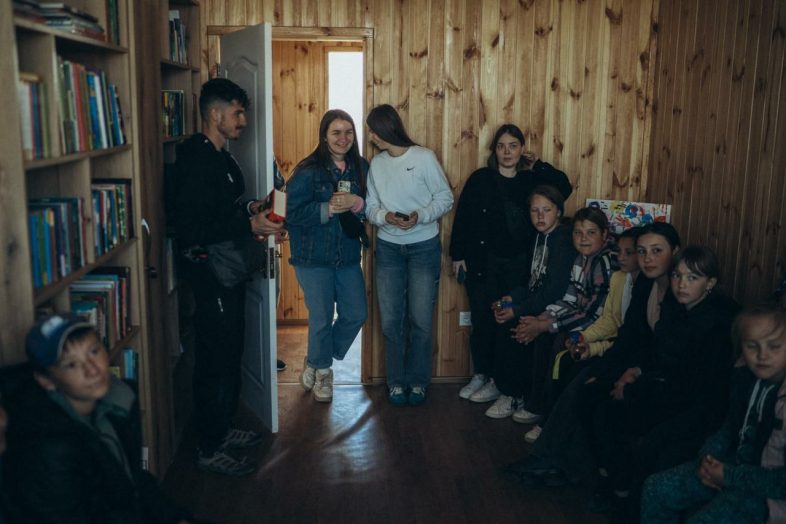As part of a joint project with the UCU School of Journalism and Communications focused on youth and civic initiatives during the war, The Ukrainian Week interviewed Kherson volunteer Stas Syniy, a co-initiator of the mobile libraries project in de-occupied villages of the Kherson region. They discussed creative solutions for establishing safe spaces for children in front-line villages.
***
— How did the idea of creating mobile libraries in front-line villages come about?
— At first, we weren’t thinking about setting up a library. Our main goal was to create a safe space for children. After Kherson was liberated, we were focused on delivering humanitarian aid, but we soon encountered the problem of large areas being mined—a dangerous issue that unfortunately continues to this day. Children were getting injured from these mines, so our priority became finding a way to provide them with a secure environment. That’s when my sister Tetiana suggested adding a library to the mix. She realised that the safety issue was just one part of the problem. During the Russian occupation, educational opportunities were almost non-existent, leaving a gap in the kids’ intellectual development. So, we thought, why not combine both needs? We ended up creating a space that not only ensures safety but also fosters learning and growth.
— What does the mobile library look like?
— Picture a cosy little building, just about 20 square meters in size, with a warm wooden interior. We wanted it to feel more like a welcoming open space than the traditional school library. Inside, you’ll find comfy cushions to sink into, a projector for movies or presentations, and a great selection of books. Plus, there’s a variety of board games to keep everyone entertained. It’s designed to be a relaxing and engaging spot where kids can both unwind and explore new worlds.
— What influences the decision on where to place the library?
— We focus on villages that need help the most, especially those that were right on the front lines and are almost completely destroyed. Take, for example, one village we worked in where 95% of the buildings were rubble, yet over 120 children and teenagers still lived there when we set up the library. We also choose villages that aren’t hit by shelling as frequently as Kherson to make sure they’re relatively safe.
Another key factor is having a committed local person—a librarian, teacher, or even a caring parent or grandparent—who can be there every day. Since we can’t always be on-site, we set up the library and rely on someone from the community to handle the day-to-day operations. It’s all about creating a lasting impact through local support and engagement.

— Who takes care of the library after it’s set up?
— We work closely with the community to decide where to place each library. Our team aims to visit these villages about once a month. During these visits, which can last anywhere from a few hours to a couple of days, we bring a variety of activities to life. Imagine kids joining in on lively exercises, dancing their hearts out, singing their favourite songs, and participating in engaging workshops. It’s all about creating a vibrant and supportive environment that makes every visit a memorable experience.
— Where is the construction of the libraries done?
— We started building the first library in the village of Pervomaisk in the Mykolaiv region because, after Kherson’s deoccupation, there was simply nowhere to build it. It was impossible to even gather craftsmen. However, the second library was 99.9% built in Kherson, my hometown. This made everything much more straightforward: you know everyone and understand where and what can be obtained, what can be ordered, and where to find cheaper options. On-site, there’s a firm with excellent craftsmen who do quality work and consider all the fire safety nuances, which is extremely important to us. Additionally, it’s much more cost-effective. We spent only 10% on transporting the second library compared to the logistics cost of the first one.
— What stories have impacted you the most throughout your work?
— Last year, we held a two-day camp in a village. During the event, it was quiet and peaceful. We did exercises with the children, sang, and played games. One of our goals for these camps is for volunteers to truly connect with the children, not just come and go. Unlike the usual “bring and drop off” approach to humanitarian aid, we aim to understand these children’s lives and how else we can help them. A week or two after we returned from that trip, a rocket hit the village at night. It struck the house of a boy most of our team had befriended. The entire family died: the boy, his newborn sister, and their parents. Such stories are tough to accept.
— Do you have psychologists on your team?
— In March 2024, our whole team took part in training with a psychologist to gain a solid foundation in working safely and effectively. While we’re not claiming to be psychologists ourselves, most of us now have a good grasp of the essentials. On top of that, we have a few certified practising psychologists on our team, including one who’s currently working on her doctoral thesis in the field.
— How about the brighter moments? Any uplifting stories from your work?
— Absolutely, there are many heartwarming stories. For example, in the village where we set up our first library, there was a family with two children. The Russians had stolen all their household appliances and bicycles. The kids dreamed of having bikes again. At that time, we managed to involve partners from the USA, who we had informed about our project. Eventually, they bought bicycles for this family. You should have seen the children’s eyes light up when we delivered the bikes. It took me back to when I was 13, and my father bought me my first bicycle.

